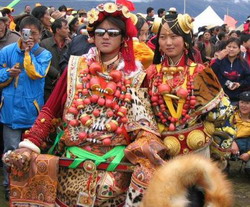
Most Tibetan marriages are monogamous with familiar 'nuclear' families. In many ancient societies, however, multi-wives families were common, and most Tibetan kings have several wives.
The number of monks in Tibet in 1950 was about 110,000 -- which would be the equivalent per capita of the US having 27 million monks, of which about 35 percent would be of marriageable age. This creates a shortage of available males; and in many sparsely populated areas, it is hard to find a suitable spouse. Sometimes, in order to maintain a household and to avoid the dividing of property, a younger son is sent to the monastery to be a monk -- the equivalent of knighting a younger son without property in England -- and when the younger brother reaches adulthood, he shares his elder brother's wife.
Girls in Tibet are initiated ceremoniously into adulthood, selecting a 'lucky' date according to the Tibetan calendar. Her hair will be plaited from a single to many braids and she will begin wearing a colorful 'apron', indicating her availability for marriage and male friendships.
Public gatherings are considered appropriate occasions for boys to meet girls. Romantic bonfires in the moonlight draw boys and girls together to sing and to worship. After a period of courtship and permission, each family has granted to the marriage. An elderly gentleman is asked to propose the marriage to the bride-to-be's parents. According to tradition, only the maternal uncle of the girl has the right to approve. Suitable gifts are presented to the bride's family once approval has been given.
The day before the wedding, the maternal uncle of the groom takes gifts and often a white horse for the bride to ride on to the bride's house or tent. Two maidens from the bride's family greet the uncle and they share three wedding toasts of beer. The uncle presents a ceremonial scarf to the bride's parents and blesses the household and all of its members.
On the wedding day, the groom's house or tent is refurbished. Bowls are painted with eight auspicious emblems ready for use, and a square carpet of white wool is laid to welcome guests.
The bride puts on a white woolen wedding gown and rides a white horse to the groom's house, escorted by her uncle and her groom's uncle. His uncle rides ahead to announce her arrival. Another 'wedding toast' is sung by two maidens who are from the groom's family while the bride dismounts in front of the groom's house, stepping precisely in the middle of the white mat, on which an emblem is formed from grains of barley.
The groom's family asks him to dismount and come in. Another ceremonial scarf is exchanged, and blessings are invoked. The groom's uncle formally begins the wedding ceremony, during which the bride and groom kneel in front of the groom's uncle and a picture of Buddha while monks chant. The bride serves milk-tea to her future in-laws and flicks a fingertip of the tea above her head to salute heaven, earth, and Buddha.
The wedding ceremony is followed by a joyful wedding feast, which is liberally interrupted by many presentations of ceremonial scarves, blessings, and gifts -- so many that sometimes the groom and bride are nearly buried beneath the large number of scarves tied around their necks!
 China tours inclusive of visiting Shigatse China tours inclusive of visiting Shigatse
|